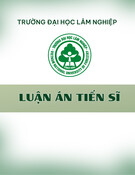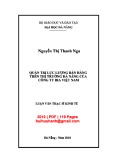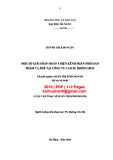
iv
TABLE OF CONTENTS
DECLARATION ................................................................................................... i
ACKNOWLEDGEMENTS ..................................................................................... ii
TABLE OF CONTENTS ........................................................................................ iv
LIST OF TABLES ................................................................................................ vii
LIST OF FIGURES ............................................................................................. viii
LIST OF PUBLICATIONS ..................................................................................... ix
GLOSSARY OF ACRONYMS ................................................................................. x
ABSTRACT ........................................................................................................ 1
CHAPTER 1: INTRODUCTION ............................................................................. 3
1.1. MOTIVATIONS ........................................................................................... 3
1.2. RESEARCH CONTEXT ................................................................................ 12
1.3. RESEARCH QUESTION AND OBJECTIVES ................................................... 15
1.4. STRUCTURE OF THE THESIS ...................................................................... 16
CHAPTER 2: LITERATURE REVIEW ................................................................... 18
2.1. SUPPLIER RELATIONSHIP MANAGEMENT – A HISTORICAL OVERVIEW ..... 18
2.2. PORTFOLIO APPROACH TO SUPPLIER RELATIONSHIP MANAGEMENT ...... 23
2.3. ASSESSMENT OF THE SUPPLIER RELATIONSHIP MANAGEMENT PORTFOLIO
MODELS ......................................................................................................... 50
2.4. LITERATURE ON PURCHASING PRACTICES IN SMALL FIRMS ..................... 57
CHAPTER 3: RESEARCH METHODOLOGY ......................................................... 66
3.1. RESEARCH DESIGN ................................................................................... 66
3.2. DATA COLLECTION ................................................................................... 73
3.3. DATA ANALYSIS ....................................................................................... 79
3.3.1. Within-Case Analysis ......................................................................... 79
3.3.2. Cross-Case Analysis ........................................................................... 85
3.4. DATA VALIDITY ........................................................................................ 88
3.4.1. Construct Validity .............................................................................. 89
3.4.2. Internal Validity ................................................................................. 89
3.4.3. External Validity ................................................................................ 90
3.4.4. Reliability .......................................................................................... 91
CHAPTER 4: WITHIN-CASE ANALYSIS .............................................................. 92
4.1. CASE 1 – SMAGR1 .................................................................................... 92
4.1.1. Background and Characteristics ........................................................ 92
4.1.2. Suppliers Classification ...................................................................... 93
4.1.3. Power Relations with Suppliers ......................................................... 97
4.1.4. Supplier Relationship Management Strategies .................................. 98
4.1.5. Supplier Relationship Management Postures: A Synthesis ...............103
4.2. CASE 2 – SMAGR2 ...................................................................................105
4.2.1. Background and Characteristics .......................................................105
4.2.2. Suppliers Classification .....................................................................107
4.2.3. Power Relations with Suppliers ........................................................109
4.2.4. Supplier Relationship Management Strategies .................................113
Table 4.2.2 summarizes the range of SRM strategies SMAGR2 adopted. .......118































